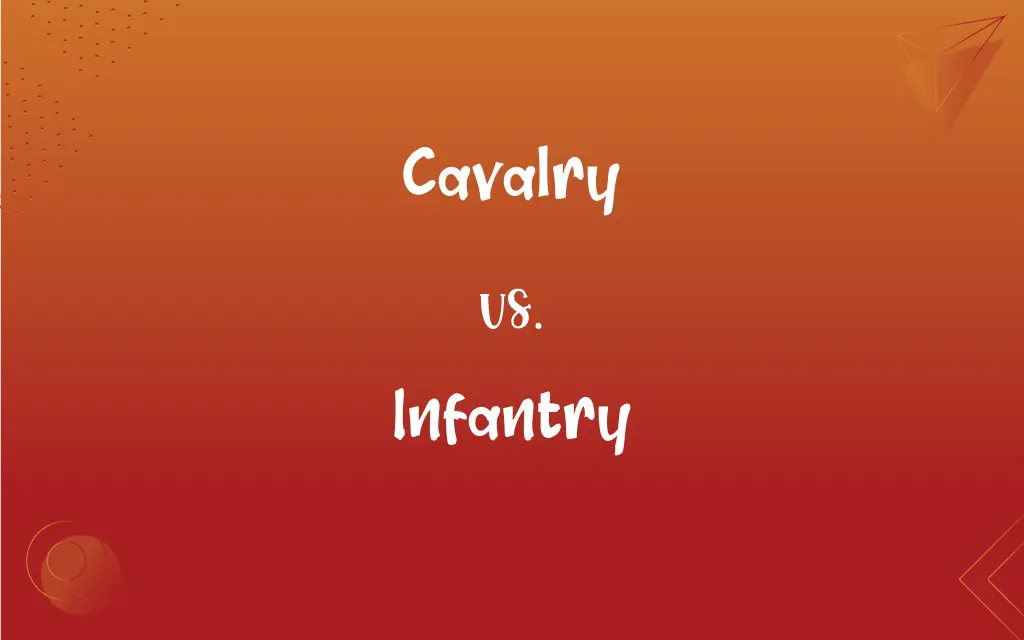Cavalry vs. Infantry: What's the Difference?
Edited by Harlon Moss || By Janet White || Updated on October 10, 2023
Cavalry consists of soldiers who fight on horseback, while Infantry comprises foot soldiers who fight on the ground.

Key Differences
Cavalry and Infantry are fundamental divisions within most historical military forces, each offering unique strategic advantages. Cavalry, often recognized by its mounted soldiers atop horses, focuses on mobility, speed, and swift offensive capabilities. Conversely, Infantry, characterized by foot soldiers, forms the main body of an army and is often employed in direct combat.
Historically, Cavalry units have been utilized for reconnaissance, raiding, and even psychological warfare due to their ability to move quickly across the battlefield. The sight of a charging Cavalry could easily strike fear into the heart of the enemy. Infantry, being on foot, have been the backbone of many armies, holding lines, capturing territories, and engaging directly with opposing forces.
It's vital to note that while Cavalry benefits from the speed and height advantage of their mounts, they can be vulnerable in certain terrains or against particular defenses. Infantry, although slower, offers greater staying power in prolonged battles and is versatile across various terrains.
Modern warfare has evolved, and the traditional roles of Cavalry and Infantry have adapted. The term "cavalry" is sometimes used to describe units that rely on speed and mobility but may not necessarily involve horses, such as armored units. Infantry, meanwhile, continues to be a predominant force, now further equipped with advanced weaponry and technological support.
Comparison Chart
Basic Definition
Soldiers on horseback
Foot soldiers
ADVERTISEMENT
Primary Advantage
Speed and mobility
Versatility and staying power
Typical Historical Role
Reconnaissance, raiding
Holding lines, direct combat
Terrain Suitability
Open terrains, plains
Varied terrains, including urban landscapes
Evolution in Modern Warfare
Adapted to armored units
Enhanced with advanced weaponry
Cavalry and Infantry Definitions
Cavalry
A unit emphasizing speed and mobility in warfare.
The Cavalry unit was sent ahead for reconnaissance.
ADVERTISEMENT
Infantry
Soldiers who fight on foot.
The Infantry advanced steadily towards the city.
Cavalry
Soldiers using horses for combat or transportation.
With their horses, the Cavalry could cover great distances rapidly.
Infantry
Ground forces of an army.
The Infantry bore the brunt of the frontline combat.
Cavalry
The mounted section of a military force.
The king always had a dedicated Cavalry at his disposal.
Infantry
The primary land-based military force.
The Infantry held their positions against the onslaught.
Cavalry
Swift-moving troops, historically on horses.
The enemy's defenses crumbled before the might of the Cavalry.
Infantry
Foot soldiers used in direct combat roles.
The dense forests provided cover for the advancing Infantry.
Cavalry
Troops trained to fight on horseback.
Infantry
The branch of an army made up of units trained to fight on foot.
Cavalry
A highly mobile army unit using vehicular transport, such as light armor and helicopters.
Infantry
Soldiers armed and trained to fight on foot
The general ordered his infantry to attack.
Cavalry
The military arm of service that fights while riding horses.
Infantry
A unit, such as a regiment, of such soldiers
Company B of the 7th Infantry.
Cavalry
An individual unit of the cavalry arm of service.
Infantry
Soldiers who fight on foot (on land), as opposed to cavalry and other mounted units, regardless of external transport (e.g. airborne).
Cavalry
The branch of the military transported by fast light vehicles, also known as mechanized cavalry.
Infantry
(uncountable) The part of an army consisting of infantry soldiers, especially opposed to mounted and technical troops
Cavalry
(figurative) Source of rescue, especially in an emergency.
Call in the cavalry
Infantry
A regiment of infantry
Cavalry
That part of military force which serves on horseback.
Infantry
A body of children.
Cavalry
Troops trained to fight on horseback;
500 horse led the attack
Infantry
A body of soldiers serving on foot; foot soldiers, in distinction from cavalry.
Cavalry
A highly mobile army unit
Infantry
An army unit consisting of soldiers who fight on foot;
There came ten thousand horsemen and as many fully-armed foot
Cavalry
Military troops trained to fight on horseback.
The charging Cavalry swiftly overwhelmed the enemy.
Infantry
Troops trained for ground battles.
The hilltop was secured by the relentless Infantry.
FAQs
Is cavalry effective in all terrains?
No, cavalry units are typically less effective in difficult terrains like dense forests or swamps, which impede movement.
Do modern armies still use cavalry?
Yes, but it’s now mechanized cavalry, using vehicles instead of horses, serving similar strategic roles with updated technology.
Were cavalry units primarily composed of elite soldiers?
Often, yes. Historically, cavalry units often consisted of well-trained, sometimes noble warriors due to the cost of horses and equipment.
What is the primary role of the cavalry in warfare?
The cavalry traditionally serves for fast, mobile offenses, scouting, and providing rapid response in battles.
How is "infantry" distinguished from other military branches?
Infantry specifically refers to foot soldiers, distinguished from other branches like cavalry (mobile units, historically horse-mounted) and artillery (units operating heavy weapons).
What is the origin of the word "Cavalry"?
"Cavalry" originates from the French word "cavalerie," related to the Latin "caballus," meaning horse.
What characterizes infantry units?
Infantry refers to soldiers who fight while on foot, engaging in both ranged and hand-to-hand combat.
How are infantry units typically deployed in battle?
Infantry can be deployed in various formations depending on the battle strategy, like lines, columns, or squares, and they often form the main body of an army.
Which military strategies often involve both cavalry and infantry?
Strategies like the "hammer and anvil," where infantry pins the enemy (anvil) and cavalry delivers a flanking charge (hammer), often involve both.
What's the significance of infantry in modern warfare?
Infantry remains crucial for tasks like occupying territory, urban combat, and other situations requiring ground-level engagement.
Is infantry training physically demanding?
Yes, infantry training is rigorous, focusing on physical fitness, combat skills, and survival techniques.
Are there symbolic or historical significances to cavalry and infantry?
Both have rich histories and have become symbols of bravery, strategy, and the changing face of warfare over time.
Can women serve in cavalry and infantry units?
Yes, many modern armies allow women to serve in various roles within cavalry and infantry units.
Have the roles of cavalry and infantry evolved over time?
Yes, technological advancements and changing warfare strategies have evolved their roles, notably through mechanization and new combat tactics.
About Author
Written by
Janet WhiteJanet White has been an esteemed writer and blogger for Difference Wiki. Holding a Master's degree in Science and Medical Journalism from the prestigious Boston University, she has consistently demonstrated her expertise and passion for her field. When she's not immersed in her work, Janet relishes her time exercising, delving into a good book, and cherishing moments with friends and family.
Edited by
Harlon MossHarlon is a seasoned quality moderator and accomplished content writer for Difference Wiki. An alumnus of the prestigious University of California, he earned his degree in Computer Science. Leveraging his academic background, Harlon brings a meticulous and informed perspective to his work, ensuring content accuracy and excellence.































































